Traditional English Crumpets
This post may contain affiliate links. See my disclosure policy.
Crispy, chewy and delicately spongy in texture with a delicious depth of yeasty flavor, look no further for the best and most authentic crumpets recipe! Serve these homemade crumpets with fruit preserves, marmalade, honey, or just slather on the butter and you’re all set for enjoying one of Great Britain’s most iconic foods!

Homemade Crumpets
When I moved to England where I lived for 7 years, there were a number of quintessential British dishes I was eager to try. Crumpets was one of them. We had no sooner settled into our hotel room than we went grocery shopping at the local Tesco and I picked up a package of them for the following morning. We popped the them in the toaster, slathered them with butter and jam and took our first bite of English crumpets.
The verdict: The butter and jam were good. Excessively spongy in texture and bland in flavor, I wondered why, of all things, crumpets had earned such a prominent place on the British table. I swiftly wrote crumpets off as “tried them once and once was enough.”
….That is, until I ate some homemade crumpets at a friend’s house. My opinion of the famous crumpet made a 180 degree turn! Simultaneously crispy, chewy and delicately spongy in texture with a wonderful depth of yeasty flavor, I can promise you – homemade crumpets are everything they’re chalked up to be! Continue below to our crumpet recipe learn how to make the BEST homemade crumpets EVER!
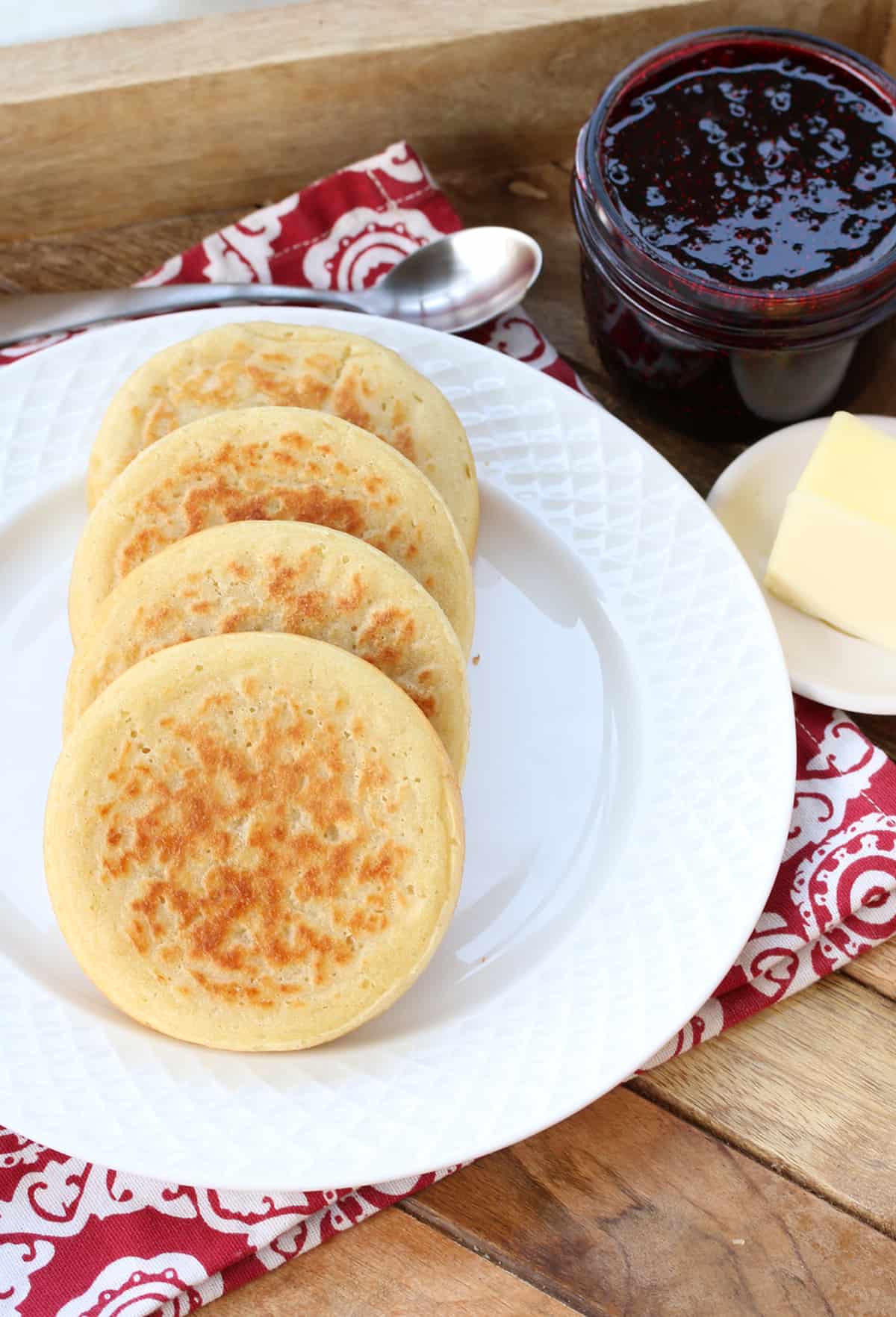
What is a Crumpet?
A crumpets is an English griddle cake made from flour, milk/water and yeast and is traditionally eaten for breakfast or with afternoon tea. Crumpets are soft and somewhat spongy in texture and their crowning feature are the dozens of tiny holes that dot the surface, allowing whatever you spread on them to soak down into them, making each and every bite an unforgettable one.
Where Did They Originate?
Crumpets originated in United Kingdom and one of the earliest mentions of “crumpet” came from the English Bible translator, John Wycliffe, who referred to them as “the crompid cake.” The name is thought to have either Old English origins (crompeht) or Celtic origins referring to a “thin, flat cake” (i.e., Breton: krampouezhl; Cornish: krampoeth; or Welsh: crempog or crempot, a type of pancake).
The crumpet has evolved over time. Centuries ago they were made without yeast and were flatter and harder, more like pancakes (what is also a Welsh variation, bara piglydd or pyglyd, known as pikelets, likewise enjoyed throughout Australia and New Zealand). During the Victorian era the yeast was introduced and crumpets have never been the same since – for the better.
Crumpet vs English Muffin
Crumpets and English muffins are sometimes confused and while it’s true that they’re both cooked on a griddle, they are distinctly different. English muffins are more like bread rolls; they’re doughy, heavier and bread-like. (Check out my recipe for Sourdough English Muffins.) English muffins are also cut in a half for serving.
Crumpets are lighter and spongier in texture both as a result of different ingredients/ratios as well as technique and the dual rising method that gives them a different texture, consistency and appearance (specifically the dozens of tiny holes that dot the top surface). Unlike English muffins, crumpets are not split in half for serving. Instead the butter, honey, jam, etc and spread right on top of the toasted crumpet.

How to Make Crumpets
Crumpets are pretty straightforward to make and because they’re made with yeast they share some similarities with bread-making like:
- Making the batter (dough)
- Letting it “rise” (in the case of crumpet batter it will get puffy and bubbly)
- “Baking” it (in this case cooking it on a griddle on in a skillet inside individual rings).
Before we get started there are a few important questions I frequently get asked that I want to address to help ensure that your crumpet-making experience is a success!
How Long Should Crumpet Batter Rest?
Different recipes recommend different times. The batter is ready after sitting for 30 minutes (crumpets in above pics were made after 30 min) but I have found that letting it rest a bit longer will give you an even higher rise and a lighter texture. In the pic below I let the batter sit for an additional 20 minutes. See the side-by-side pic for a comparison of height. Try both and see which you prefer. Both are excellent but I slightly prefer the higher rise for that lighter, airer texture.
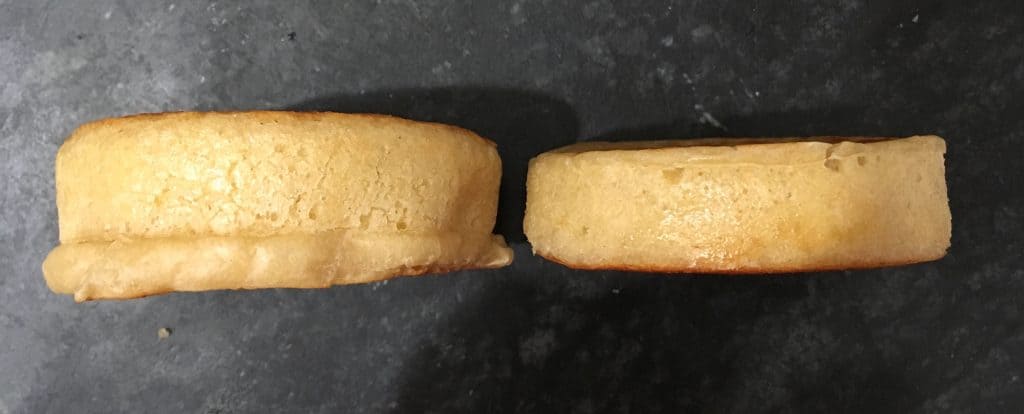
Equipment: Do I Need Crumpet Rings?
Yes. Crumpet batter is very loose and runny and the crumpets rings are what will shape and hold the batter while the crumpets are cooking.
I use Norpro’s English Muffin/Crumpet Rings. They do the job perfectly. Is there a substitute? Well, sort of. In a pinch I’ve had readers report success with using wide mouth jar canning bands but the bands have ridges which the batter will easily get stuck in, so just a heads up that it may result in frustration.
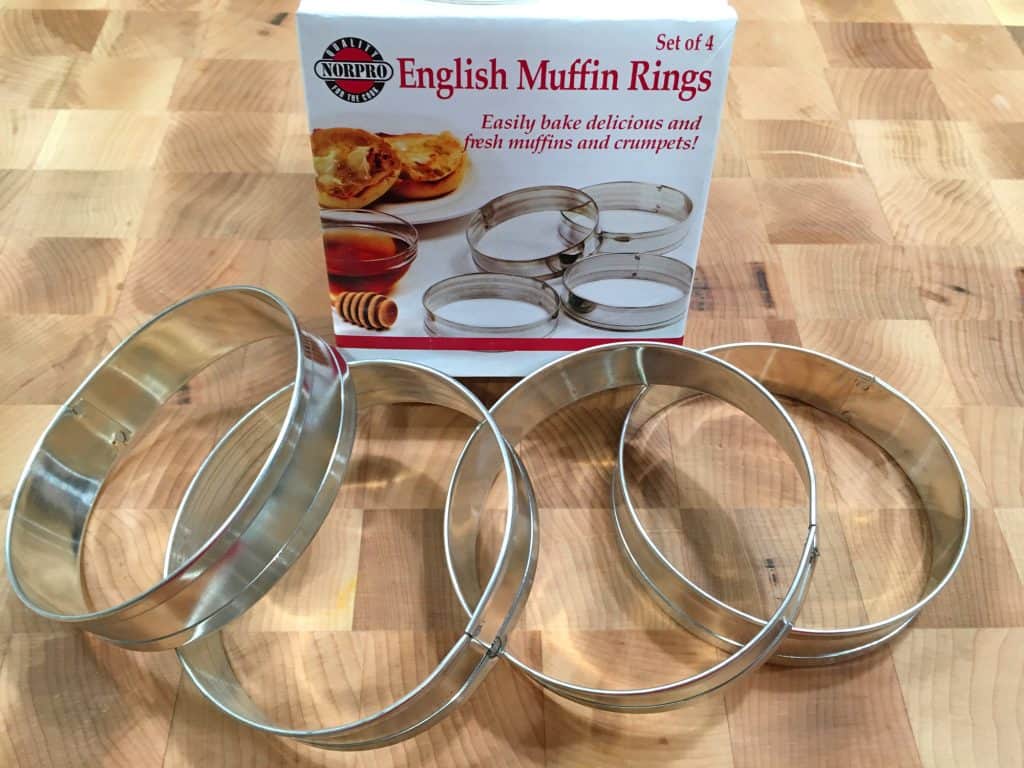
Crumpets Recipe
Let’s get started!
Stir the sugar and yeast into the warm milk and let it rest for 10 minutes until frothy. In a large mixing bowl or the bowl of a stand mixer combine the flour and salt.
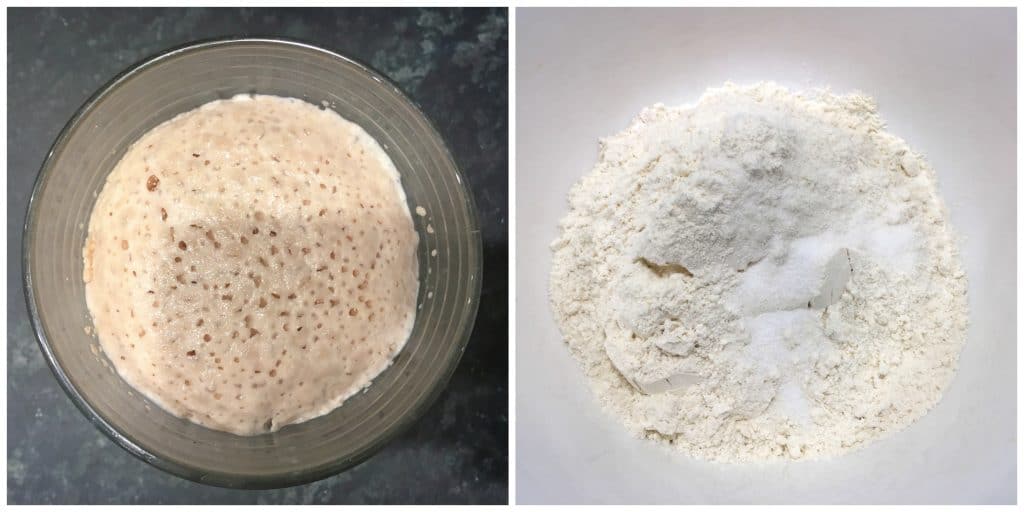
Add the liquid to the flour mixture and stir/knead until a thick dough forms. If using a stand mixer, use the paddle attachment and beat the mixture for about 3 minutes until a thick dough forms.
Cover the bowl loosely with plastic wrap and set it in a warm place to rise for at least an hour or up to two (it should nearly double in size). This stage is important for the formation of the bubbles that will later form the classic holes in the crumpets.
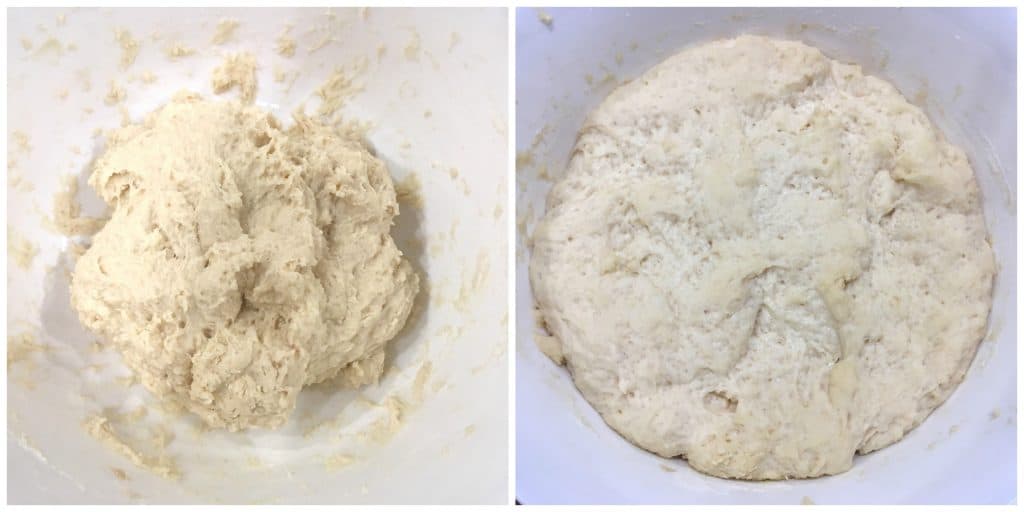
Dissolve the baking soda in the warm water and add it to the dough. In addition to the previous proving phase, the baking soda is also what helps aerate the crumpets to give them their classic pores. Those pores allow the butter later on to soak beautifully into the crumpet and gives them their famous sponge-like texture.
If using a stand mixer, beat the batter for a minute or two. Or use an electric mixer to beat the batter. If some small lumps remain that’s okay. Any remaining lumps will dissolve during the next resting stage.
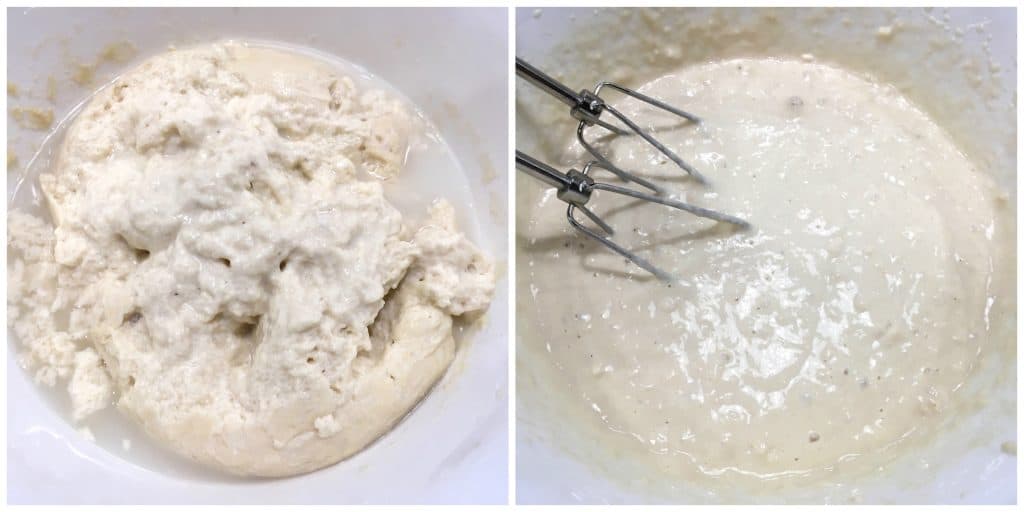
Cover the batter and let it rest in a warm place for at least 30 minutes (see note below comparing the rise of the crumpets depending on how long the batter sits).
After 30 minutes the batter should be nice and bubbly. When you stir it, it will bubble and froth nicely.
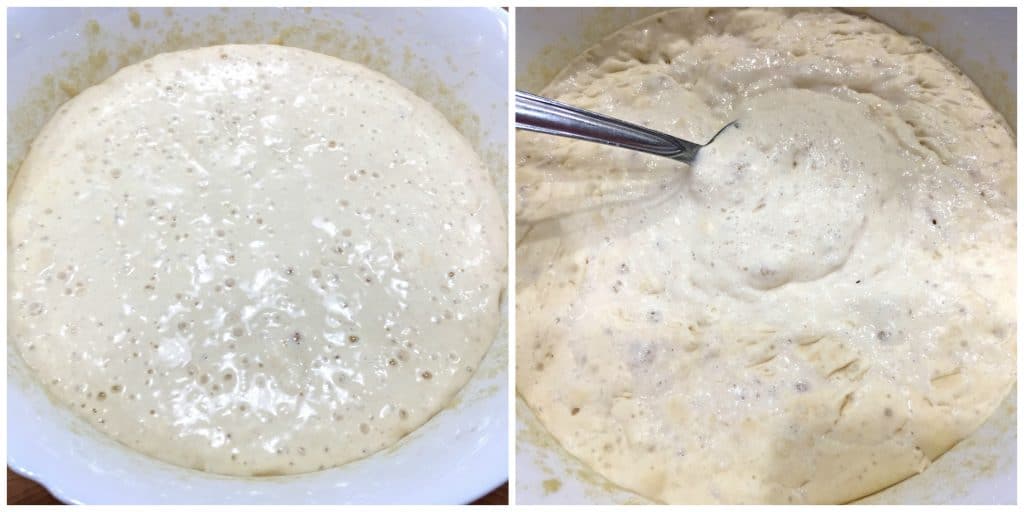
Prepare the crumpet rings: Oil the inside rims of the crumpet rings. Lightly oil the frying pan. You can use a regular skillet or a cast iron pan (my preference). I’m using my Lodge 12″ Cast Iron Pan.
Heat the pan and rings over medium-high heat. Once the rings are hot, pour the batter into each ring until it’s slightly more than half full.
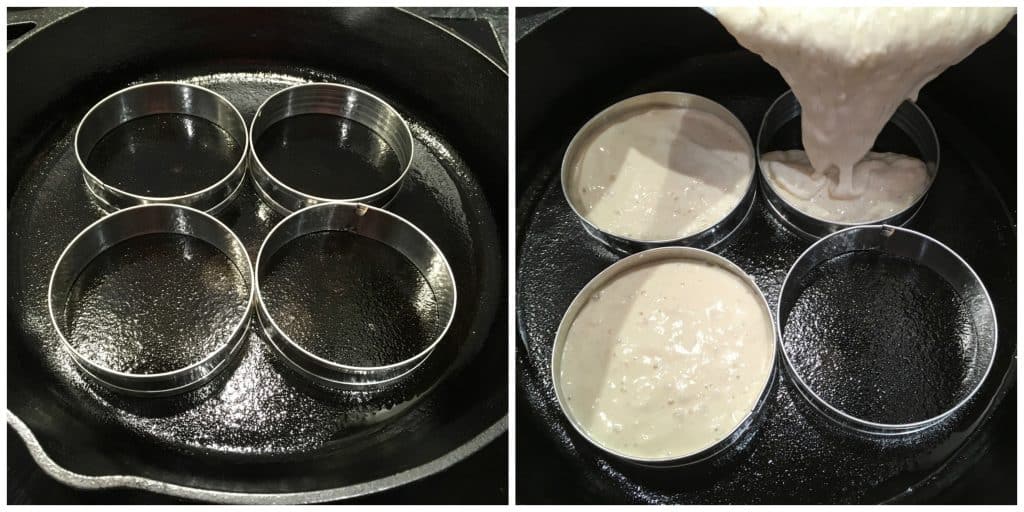
Cooking time will vary depending on your stovetop and frying pan but these will cook for approx 8-10 minutes (the time will vary according to the kind of cooktop and cookware you’re using. Just be sure to keep an eye on them to ensure they don’t burn on the bottom. Lower the temp as needed to finish off the cooking).
The batter will begin to rise and bubble on top.
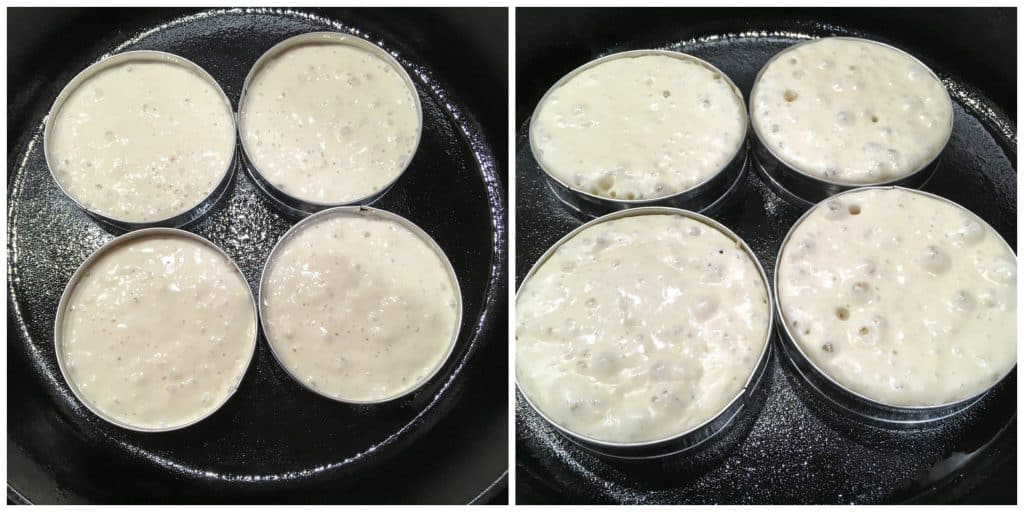
After several minutes when the tops are cooked and the classic pores/holes are present with the bottoms lightly browned, your crumpets are done and you can remove the rings.
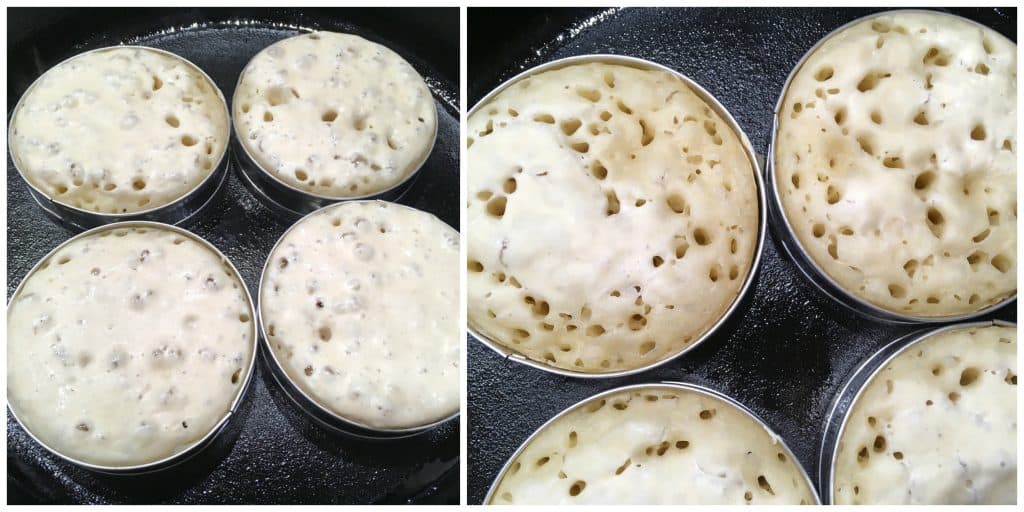
Traditionally crumpets are only cooked on one side only, not flipped over, and then toasted later. However, if you’re going to eat the crumpets immediately, I prefer to remove the rings and flip the crumpets over to cook an extra minute or two on the top side for a nice golden color and added layer of crispiness. If you flip them be careful not to move them so you don’t smear any uncooked batter and thereby cover over the pores.
If you’re keeping them for later or plan on freezing them, you have the option to flip or not flip – either way you’ll want to toast them to reheat them.
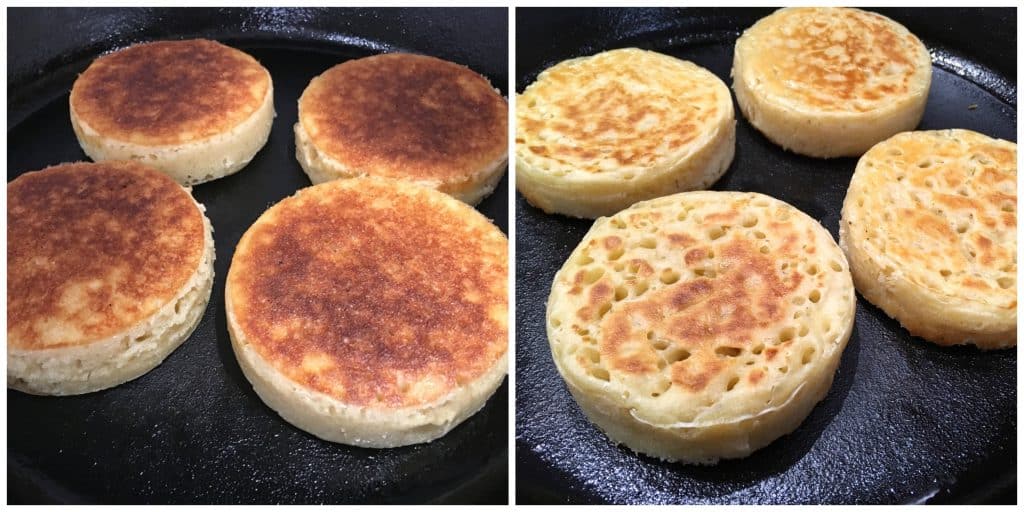
Your gorgeous, delicious homemade crumpets are ready to eat!
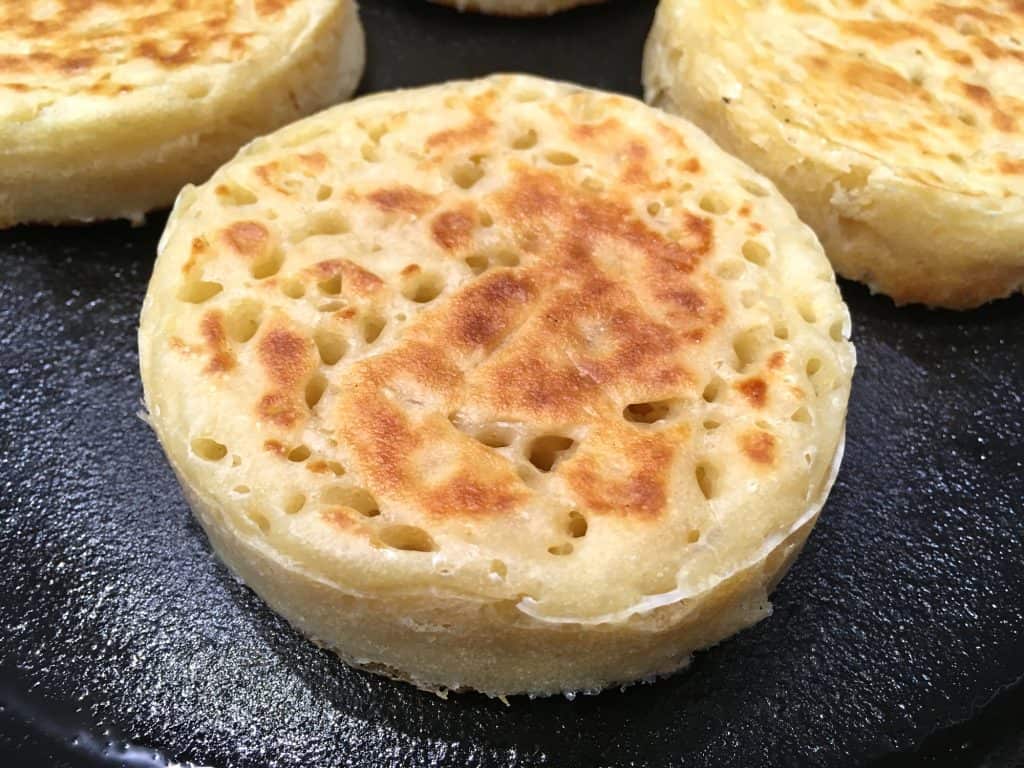
How to Eat Crumpets
Store-bought crumpets are always toasted before eating them because they’ve become soft from sitting in the packaging. However homemade crumpets straight out of the frying pan will be wonderfully crispy on the outside so there is no need to toast them. If you’re not serving them immediately toast them just before serving. Note: Crumpets are eaten whole/open-faced and are not cut in half horizontally.
Serve the crumpets warm slathered with butter, jam, golden syrup, honey or topping of your choice. Check out my recipes for homemade Black Currant Jam, Strawberry Rhubarb Jam, Gooseberry Jam, Blackberry Jam, Plum Jam, Lemon Lime Marmalade and Lemon Curd.
Storage and Freezing
Store the crumpets in an airtight container in the fridge where they will keep for 4-5 days. They also freeze well for up to 3 months. To freeze them, let them cool completely, place them in a ziplock freezer bag or freezer safe container, and put them in the freezer. When you’re ready to eat them, let them thaw on the counter, in the microwave, or in the fridge overnight and then toast them.

Enjoy!
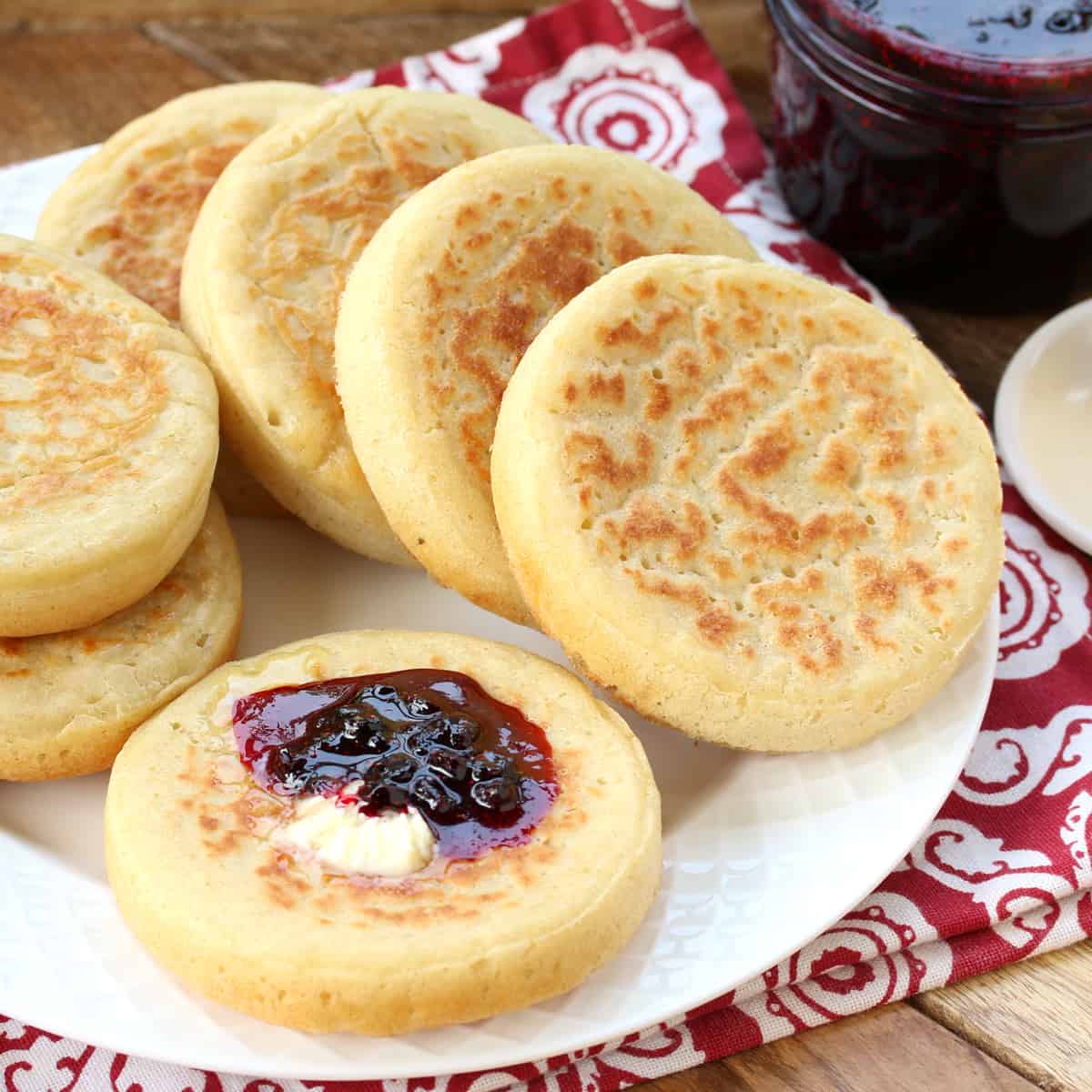
For more classic British recipes be sure to try my:
- Yorkshire Pudding
- Suet Dumplings
- Fish and Chips
- Mushy Peas
- Bangers and Mash
- Scotch Eggs
- Sticky Toffee Pudding
- Chelsea Buns
- Victoria Sponge Cake
- Treacle Tart
- Lardy Cake
- Hot Cross Buns
- Eccles Cakes
- Spotted Dick
- Figgy Pudding
- Flapjacks
- Toad in the Hole
Save This Recipe
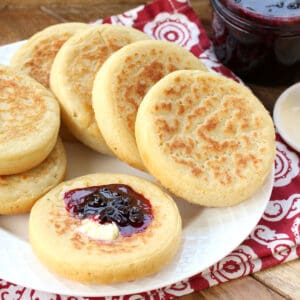
Traditional English Crumpets
Ingredients
- 2 cups all-purpose flour (can substitute half bread flour)
- 1 teaspoon salt
- 1 cup warm milk
- 2 teaspoons active dry yeast
- 1 teaspoon cane sugar
- 1 cup warm water
- 1/2 teaspoon baking soda
Instructions
- Stir the sugar and yeast into the warm milk and let it rest for 10 minutes until frothy. In a large mixing bowl or the bowl of a stand mixer combine the flour and salt.
- Add the liquid to the flour mixture and stir/knead until a thick dough forms. If using a stand mixer, use the paddle attachment and beat the mixture for about 3 minutes until a thick dough forms. Cover the bowl loosely with plastic wrap and set it in a warm place for at least an hour or up to two to let the dough rise (it should nearly double in size). This stage is important for the formation of the bubbles that will later form the classic holes in the crumpets.
- Dissolve the baking soda in the warm water and add it to the dough. If using a stand mixer, beat the batter for a minute or two. Or use an electric mixer to beat the batter. If some small lumps remain that’s okay. Any remaining lumps will dissolve during the next resting stage.Cover the batter and let it rest in a warm place for at least 30 minutes (see note below). After 30 minutes the batter should be nice and bubbly.
- Prepare the crumpet rings by greasing the inside of each rim. (I use and like Norpro's English Muffin/Crumpet Rings.) Lightly oil the frying pan. You can use a regular skillet or a cast iron pan (my preference). I use my Lodge 12" Cast Iron Pan.Place the rings in the frying pan over medium-high heat.
- Once the rings are hot, pour the batter into each ring until it's slightly more than half full. Cooking time will vary depending on your stovetop and frying pan but these will cook for approx. 10 minutes (**the time will vary according to the kind of cooktop and cookware you're using and may take longer. Just be sure to keep an eye on them to ensure they don't burn on the bottom. Lower the temp as needed to finish off the cooking). Turn the heat down as needed to prevent burning. The batter will begin to rise and bubble on top. After several minutes when the tops are cooked and the classic pores/holes are present with the bottoms lightly browned, your crumpets are done. Note: You can either remove the rings and flip the crumpets over to cook the other side for another minute or two until golden or remove them from the rings and toast the crumpets. (See blog post for more info on this.)
- Serve the crumpets immediately slathered with butter, jam, golden syrup or honey. To reheat later toast them in the toaster. Can also be frozen, thaw first before toasting. (Crumpets are eaten whole/open-faced and are not sliced in half horizontally.)
- NOTE: Regarding how long to let the batter sit before using: It’s ready after 30 minutes but letting it rest a bit longer will give you an even higher rise and a lighter texture (see blog post for side-by-side comparison pics). And more bubbles means more of those classic holes in your crumpets. Try both and see which you prefer. Both are excellent.
Video
Nutrition
Originally published on The Daring Gourmet October 17, 2019




















Can you help? I followed the directions very carefully, but my crumpets never did cook all the way through. I kept leaving them on longer and longer. They looked cooked from the top. Some of them formed nice bubbles, some did not. Some were left on the griddle for at least 20 minutes. They were nicely golden brown on the bottom, some I turned over to get that nice golden colour on the top, but still, ever so doughy inside. I love heavy doughy baked goods, but this was too much for even me! I would love to know what might have gone wrong, as I would love to make them again. I
Hi Kathleen, it sounds like the heat wasn’t high enough – it was just high enough to cook the exterior but not high enough to penetrate into the middle. Also using a very heavy bottomed iron skillet is very helpful.
I just made a bunch using this recipe today. Unfortunately, they were undercooked in the center and tasted quite doughy. Not at all like I remembered when I lived in England. I’m sure it’s nothing wrong with the recipe but I’m not sure what I did wrong.
Hi Joe, it sounds like the heat wasn’t high enough – it was just high enough to cook the exterior but not high enough to penetrate into the middle. Also using a very heavy bottomed iron skillet is very helpful.
Thanks Kimberly. Today I tried again with more success. I used a cast iron pan, as you suggested, but didn’t get the temperature right (too hot this time). I forgot to add the sugar in with the yeast, so rising suffered. But yesterday’s were rated 4 out of 10, whilst today’s are at least a 7. There’s always tomorrow.
Making crumpets definitely takes practice, Joe, and it sounds like the third time will be the charm :) Keep at it and you’ll be rewarded! :)
Just wanted to say thanks. I finally got them right tonight and I’m rating them 10 out of 10! It’s a great recipe!
Hooray!! That’s wonderful, Joe, congrats on a stellar batch of crumpets and thanks so much for the feedback!
I made these today and the batter was runny and not thick like yours. I’m not sure what happened. It didn’t create the bubbles like traditional crumpets. I’ll have to try them again. For those of us using electric skillets, how hot should one cook them at?
Same thing with me Jules, not sure what I did wrong. Mine was very runny too, the first yeast stage was never thick as in the video. When I added the cup of water and bicarbonate it made it almost like water… I rested the batter but never got bubbles. I tested the bicarbonate with vinegar and it was fine. Two cups of liquid just seemed too much for two cups of flour. I’d love to know what I did wrong! I did do the first kneading yeast stage in a bread machine rather than a stand mixer, but don’t think that would be the problem? I have seen bread machine versions that did the same.
I am going to try these tomorrow! I don’t have crumpet rings but I have these teflon rings that are made for frying eggs. They should work but if not I will try the mason jar lids like mentioned in a comment above.
Awesome, Aaron, let us know how it goes!
Hi! I was wondering can you leave mixed batter overnight, also anyone tried baking them in the oven?
Thanks!
Hi Maria, if left out too long the batter will over-proof. Likewise once the baking soda is added it needs to be used pretty quickly.
I just made them ” overnight”. I used af 1/4 of the amount of yeast. I made the first half of the recipe( just containing the yeast) and let it rise overnight in the fridge. in the morning I mixed in the water and baking soda. I think they worked out fine :)
Was about to ask for photos of the process…and then saw the video. Thank you for posting. Attempting my first batch today. 🙌
Good luck, John, and please let us know how it goes!
I MADE CRUMPETS FOR THE FIRST TIME IN MY LIFE! Thank you! ❤️
Fantastic, Sarah, I’m so glad you enjoyed them, thank you!
These are great but your total time doesnt reflect the rising and sitting times. Novices who have never worked with rising dough/batter scrolling through recipes for a quick breakfadt will mistakenly chose this for a fast recipe since it states 20 min total time when its morw like 90